Abstract
Background:
Curcuma longa L. is a perennial herb and a member of the Zingiberaceae (ginger) family, which is used extensively in foods as well as in Ayurvedic and Chinese systems of medicine. Current researches have focused on its antioxidant, hepatoprotective, anti-inflammatory, anticarcinogenic and antimicrobial properties. Until now, very few studies suggested its role as a histological stain.
Aim:
To ascertain its efficacy to be used as a counterstain after hematoxylin, to compare it's staining ability with that of routinely used eosin dye and also to ascertain its role in various collagen diseases.
Materials and Methods:
Turmeric rhizomes were cut into small pieces and were dried. These dried turmeric rhizomes were milled to form fine powder, which was then processed to form dye for staining tissue structures.
Results:
It revealed that turmeric can be used as a counterstain after hematoxylin, its staining ability was also good and comparable to that of eosin dye with a special affinity for collagen and muscle fibers.
Conclusion:
Turmeric dye can be used as a histological stain, which stains similar to eosin dye and its specific affinity for collagen and muscle fibers authenticates its role in the treatment of collagen and muscle disorders.
Keywords: Counterstain, Curcuma longa, eosin, hematoxylin, turmeric, Zingiberaceae
Introduction
Curcuma longa L., is commonly used as a spice in curries, food additive and also, as a dietary pigment. It has also been used to treat various illnesses in the Indian subcontinent from the ancient times. It is commonly known as turmeric however it is also known as Haldi in Hindi, Curry spice in British and Haridra in Sanskrit. It is the dried rhizome powder of C. longa, a perennial herb of the Zingiberaceae (ginger) family, which is 3–5 ft. tall bearing oblong, pointed, short-stemmed leaves and funnel-shaped yellow flowers. The rhizome of turmeric is used as a valuable cash crop, which is widely cultivated in Asia, India, China, and other tropical countries.[1] Natural dyes find use in the coloring of textiles, drugs, cosmetics, etc., Owing to their nontoxic effects, they are also used for coloring various food products.[2] Researcher in their study stained the human tissue samples with purified ethanolic extract of C. longa using the column chromatography technique and showed that the staining reaction was similar to the reaction of eosin except for its intense yellow color.[3] However, present study was performed using the crude ethanolic extract of C. longa by using our own newly devised a methodology with a view to assess the staining ability of turmeric with that of eosin.
Materials and Methods
The present experimental study was conducted in the Department of Oral Pathology and Microbiology, Kothiwal Dental College and Research Centre, Moradabad.
Method employed for turmeric dye preparation
The rhizomes of C. longa were collected from Govind Ballabh Pant University of Agriculture and Technology, Pantnagar, Uttrakhand, India. Rhizomes were then cut into small pieces and were dried. They were then milled to form fine powder using mixer [Figure 1], 15 g of this powdered plant material was weighed using electronic/digital weighing machine, which was then dissolved in 100 ml of 70% alcohol in a borosil beaker and was transferred to 5 ml borosil test tubes, which was then centrifuged in a centrifuge machine (REMI R4C LAB CENTRIFUGE) at 3000 rpm for 5 min and the supernatant was collected with the help of micropipettes in a coupling jar [Figure 2]. Phytochemical evaluation of this supernatant (turmeric dye) which was used for staining various tissue structures revealed the presence of flavonoids, deoxy sugars and free anthraquinone. In our study, addition of mordant like potassium aluminum alum, acidic solution like 1% glacial acetic acid, alkaline solution like 1% ammonium hydroxide were also used, but none of these improve the staining qualities of C. longa. Hence, it was concluded that turmeric dye alone should be used as a stain. In order to standardize this turmeric dye various concentrations of turmeric powder (5 g, 10 g, and 15 g) were also used in 100 ml of 70% alcohol but out of all these only 15 g of turmeric powder in 100 ml of 70% alcohol provides the best result and hence this was employed for staining the tissue sections. Thus, this is a pilot study.
Figure 1.
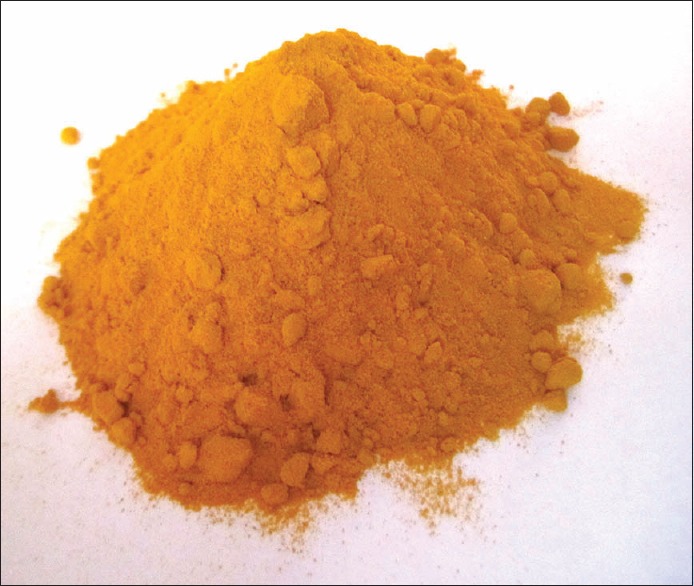
Fine turmeric powder
Figure 2.
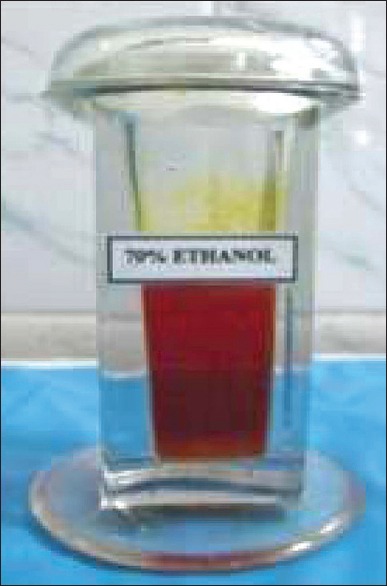
Supernatant in a coupling jar
Method employed for staining various tissue structures
One year old wax blocks of human oral tissues obtained from both healthy and pathological individuals were procured from archives of Department of Oral Pathology and Microbiology. Two sets of 5 μ thick sections were obtained. Each set comprised of 10 slides for each tissue structure. Sections were first dewaxed in xylene for 4 min and hydrated through graded solutions of alcohol and stained in alum hematoxylin for 3 min. Sections were then differentiated in 1% acid alcohol for 2–5 s and blued in tap water for 10 min. Methodology followed is with slight modification in the timing of alum hematoxylin of previous research work.[3] Now, first set of sections were then counterstained in neutral media with turmeric dye for 5 min at room temperature while the second set of sections were counterstained with the routine eosin dye for 2½ min. Sections were then dehydrated in increasing grades of alcohol, cleared in xylene and finally mounted with the synthetic (DPX) mountant. Sections were observed using binocular Olympus microscope model no. CH20i at × 10 and × 40 magnification.
Statistical analysis
This was performed using Statistical Package for Social Sciences (this software was initially produced by SPSS inc. and later on acquired by IBM in 2009) version 15.0 statistical analysis software using Mann-Whitney U-test. Statistical analysis was done by calculating P value.
Observations and Results
Ten independent oral pathologists compared the staining efficacy of turmeric with that of eosin for various tissue structures such as epithelium [Figure 3], collagen [Figure 4], muscles [Figure 5], blood vessels, nerves [Figure 6], bone [Figure 7], adipose tissue [Figure 8], and keratin [Figure 3]. For this three grading criteria were assigned:
Figure 3.
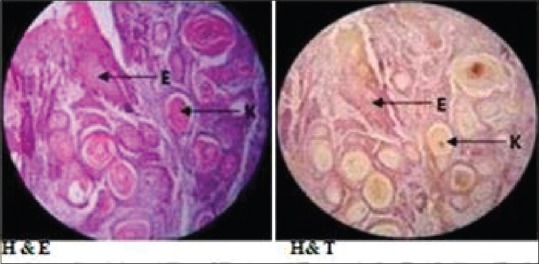
Photomicrographs of epithelium (E) and keratin (K) showing comparison of staining ability of eosin and turmeric at ×10
Figure 4.
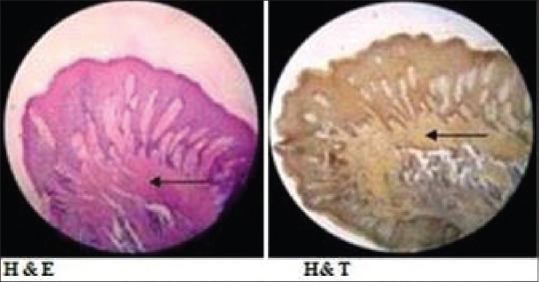
Photomicrographs of collagen showing comparison of staining ability of eosin and turmeric at ×10
Figure 5.
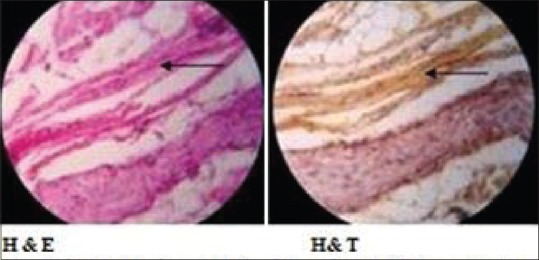
Photomicrographs of muscles showing comparison of staining ability of eosin and turmeric at ×40
Figure 6.
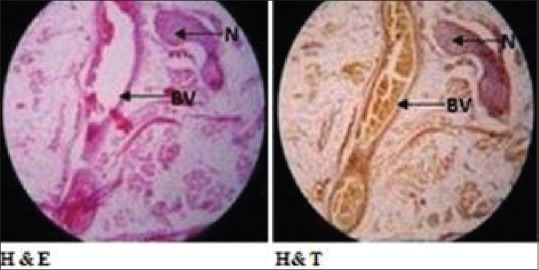
Photomicrographs of blood vessels (BV) and nerves (N) showing comparison of staining ability of eosin and turmeric at ×40
Figure 7.
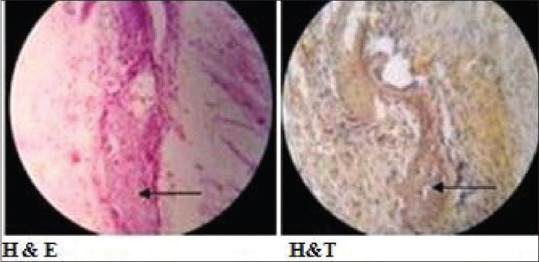
Photomicrographs of bone showing comparison of staining ability of eosin and turmeric at ×40
Figure 8.
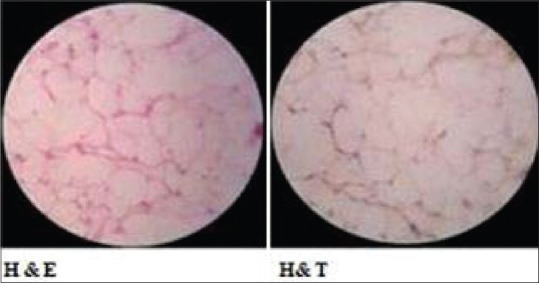
Photomicrographs of adipose tissue showing comparison of staining ability of eosin and turmeric at ×10
P (Poor) - Refers for difficulty in appreciation of a particular tissue structure
G (Good) - Refers for sufficient appreciation of a particular tissue structure
E (Excellent) - Refers for fine appreciation of a particular tissue structure.
Grading for each set of 10 slides were done for both eosin [Table 1], turmeric [Table 2] and comparison between the staining ability of eosin and turmeric was made [Table 3].
Table 1.
Grading of each set of (10) slides stained with eosin for various tissue structures by 10 independent observers
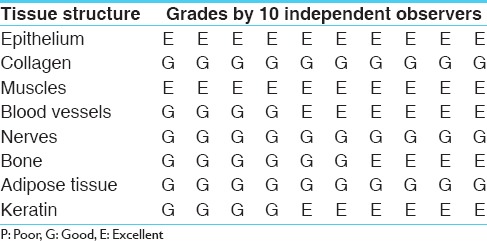
Table 2.
Grading of each set of (10) slides stained with turmeric for various tissue structures by 10 independent observers
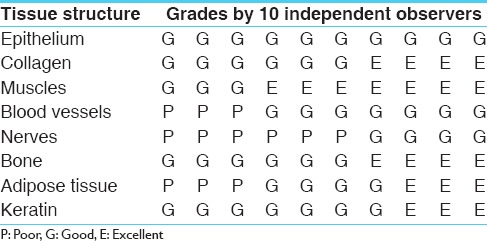
Table 3.
Comparison of staining ability of eosin and turmeric for various tissue structures

Statistical analysis revealed that, overall staining ability of eosin is better than turmeric. However, interestingly collagen, muscle fibers shows P < 0.05, which suggest that turmeric dye stain these structures in a remarkably different and distinct pattern giving deep yellowish orange color when compared to other tissues as suggested by their P values, which were 0.143 and 0.280 respectively.
Discussion
Turmeric is a rhizomatous herb that belongs to the family Zingiberaceae and the major species is genus C. longa.[4] It is a medicinal plant extensively used in Ayurveda, Unani and Siddha medicine as a home remedy for various diseases including biliary disorders, anorexia, cough, diabetic wounds, hepatic disorders, rheumatism, and sinusitis. Curcumin (Diferuloylmethane), the main yellow bioactive component of turmeric has been shown to have a wide spectrum of biological actions - anti-inflammatory, antioxidant, anticarcinogenic, antimutagenic, anticoagulant, antidiabetic, antibacterial, antifungal, antiprotozoal, antiviral, antifibrotic, antivenom, antiulcer, hypotensive and hypocholesteremic activities.[5] Since long turmeric or C. longa is valued for its principle coloring constituent curcumin, which imparts yellow color to textile fibers and food.[6] The ability of a dye to stain specific tissue structures is determined by certain factors, one of which is the acidity of the stain. Acidic structures would be stained by basic dyes while basic structures would be stained by acidic dyes.[3] Owing to the strong affinity of C. longa for the cytoplasm, it can be deduced that the C. longa extract dye is acidic in nature. This deduction is corroborated by the phytochemical analysis of the active column fraction. It contained flavonoids,[3] which are typically polyphenolic compounds. Phenols are acidic, due to their ability to release the hydrogen from their hydroxyl group, hence the ability of C. longa to stain the basic parts of the cell. C. longa also stains collagen and muscle fibers with deep yellowish orange color. However, the lack of pH sensitivity is puzzling. Regardless, when C. longa was used as a counterstain for hematoxylin, the nuclei took the blue coloration, which enabled a clear contrast to be made between the different structures of the cells. This shows that, the reaction of the C. longa stain is similar to the reaction of eosin in the hematoxylin and eosin technique except for its yellow coloration.[3] However, in routine staining of histological sections eosin is used as a counterstain after hematoxylin, but due to its synthetic and toxic properties a natural dye, i.e., turmeric was tried as a histological stain. Hence, in the present study, the staining ability of natural turmeric dye is compared with synthetic eosin dye by devising modified methodology. Results obtained were similar to those as suggested by previous research work.[3] Although, statistically eosin have proved to be better over turmeric, but turmeric have shown good and comparable staining to eosin for collagen and skeletal muscle fibers.
Turmeric probably acts by scavenging free radicals, decrease lipid peroxidation and stimulating DNA damage repair enzymes in healing oral sub mucous fibrosis a precancerous condition and also by inhibiting proliferation of fibroblasts, which proves its stronger affinity for collagen.[7] This fact is also supported by another research work.[8] Turmeric also has an ancient medicinal role in muscle sprains and injuries which suggests it's stronger affinity for muscle fibers.
Conclusion
Turmeric dye obtained from C. longa extract can be used as a histological stain in place of synthetic toxic eosin dye due to its cheap, natural, readily available and nontoxic properties. Turmeric dye stains collagen and muscle fibers with deep yellowish orange color suggesting its stronger affinity to these structures and thus, also opens a gate in the treatment of collagen and muscular disorders.
Acknowledgment
We would like to acknowledge Mr. Hemant Kumar Pant (Junior Scientific officer, Drug Control Department, New Delhi) for their assistance.
Footnotes
Source of Support: Nil
Conflict of Interest: None declared.
References
- 1.Singhal M, Yashwant, Nayak A, Singh V, Parihar AS. Curcumin: A chemopreventive agent in pre-malignant lesions. Int J Toxicol Pharmacol Res. 2009;1:27–32. [Google Scholar]
- 2.Siva R. Review article on status of natural dyes and dye-yielding plants in India. Curr Sci. 2007;92:916–25. [Google Scholar]
- 3.Avwioro OG, Onwuka SK, Moody JO, Agbedahunsi JM, Oduola T, Ekpo OE, et al. Curcuma longa extract as a histological dye for collagen fibres and red blood cells. J Anat. 2007;210:600–3. doi: 10.1111/j.1469-7580.2007.00721.x. [DOI] [PMC free article] [PubMed] [Google Scholar]
- 4.Krishnaswamy K. Traditional Indian spices and their health significance. Asia Pac J Clin Nutr. 2008;17(Suppl 1):265–8. [PubMed] [Google Scholar]
- 5.Ishita C, Kaushik B, Uday B, Ranajit KB. Turmeric and curcumin: Biological actions and medicinal applications. Curr Sci. 2004;87:44–53. [Google Scholar]
- 6.Sachan K, Kapoor VP. Optimization of extraction and dyeing conditions for traditional turmeric dye. Indian J Tradit Knowl. 2007;6:270–8. [Google Scholar]
- 7.Hastak K, Lubri N, Jakhi SD, More C, John A, Ghaisas SD, et al. Effect of turmeric oil and turmeric oleoresin on cytogenetic damage in patients suffering from oral submucous fibrosis. Cancer Lett. 1997;116:265–9. doi: 10.1016/s0304-3835(97)00205-x. [DOI] [PubMed] [Google Scholar]
- 8.Das AD, Balan A, Sreelatha KT. Comparative study of the efficacy of curcumin and turmeric oil as chemopreventive agents in oral submucous fibrosis. J Indian Acad Oral Med Radiol. 2010;22:88–92. [Google Scholar]


